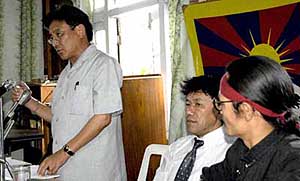White Paper and the Future of Tibet
(Community Centre, Dharamshala | June 02, 2004)

Karma Choephel (President, National Democratic Party);
Kalsang Phuntsok (President, Tibetan Youth Congress) and
Tenzin Tsundue (National Secretary, Friends of Tibet)
Dharamshala:
People in the back asked the people in the front to move forward,
those standing outside asked the people sitting at the door to
squeeze and move inside. There was an obvious commotion at the first
meeting of the Tibetans to discuss White Paper, a policy document
released by Chinese government ten days back.
Almost 300 people have huddled into the small wooden house;
Dharamshala's local community centre has seen such frantic gatherings
earlier too, but today the people are visibly anxious. The Tibetan
government in exile is yet to respond to the 37-page policy paper,
those who came late, and couldn't get a place at the door to stand
or a peeping gap in the window, were found listening to the low
volume speaker kept outside.
Friends of Tibet (INDIA), the organiser's General Secretary
Tenzin Tsundue
in his introductory note said that
"the people are concerned about the Document released are talking
about it in every corner of the community and many are concerned that
there had been no response up to now from the Tibetan Government in exile.
That's why the public gathering to discuss the paper" he reasoned.
The public gathering
"White Paper and the Future of Tibet"
was Dharamshala's first response to China's recently released policy document
"White Paper" called "Regional Ethnic Autonomy in Tibet".
The 37-page document was thrashed and trampled by the Tibetans
since the release of the paper through the 4-hour long talks and
discussion. Even before the Dalai Lamas headquarter, the Tibetan
Government in Exile had any thing to say, the Dharamshala people
gathered in hundreds, called it a bunch of lies and rejected it. One
of the speakers at the gathering Karma Choephel who is also a
Member of the Tibetan parliament called it "Black paper", and said it
is not worth of any attention. And white paper is a misnomer for it.
"If we have to learn one thing from the paper, it is this that
our long hoped Middle Way Approach is not working. Chinese has
given in writing, clearly that this is all that we can offer, and
that "Regional Ethnic Autonomy", which they say is already being
enjoyed by the Tibetans in Tibet, and nothing more than this.
We must reinstate Independence as the goal of our struggle, where it
us who decide, we would not have to wait and beg for china to talk
to us, Karma Choephel, president of national Democratic Party of
Tibet said.
Lobsang Jinpa,
the Editor of Tibetan monthly new magazine called "Sheja",
analysed the content of the document one by one and then said that the last
part of the document is a nasty one. Making a hook of his index
finger and a dry smile, he gestured emphatically. Largely the
content of the paper is same as the earlier versions of White Paper.
"This paper is a strategically planned one. China is now desperate,
as most of the western countries hold China from the collar on Human
Rights issues. China is now searching for friends in South American
continent and also in Asia" he added. Kalsang Phuntsok, the
President of the largest Tibetan NGO, Tibetan Youth Congress said in
his speech: "The document is an attempt by China to kill two birds
with one stone; while it tries to a explain to the western world
that Tibetans are developing and they are the masters of their land
on one hand, and on the other hand, it has put the efforts by the
Tibetan Exile Government for a negotiated solution in a squarely
difficult position."
The gathering saw one of the most heated discussions, where many
people placed their opinions, and some asked questions. Answering
one of the questions, Lobsang Jinpa said, "I have lived most of my
life in Tibet, and I know the lives of common Tibetans there, how
poorly and disadvantaged lives, and also how in beautiful pictures
China recreates Tibet on Television and newspapers. What China claims
on the White paper are not there in reality? I therefore join Karma
Choephel in calling this document "Black paper" while delivering
the concluding remarks, Tenzin Tsundue, held out a paper and said,
"This is all that is available in Tibetan of the White Paper a
small patch of Tibetan script in print. Why is a policy paper for
the development in Tibet not in Tibetan?" he demanded to know. "It
was released in Chinese and now available in English. Is it only a
PR exercise by China? Is there any seriousness with the development
and political rights in Tibet?" he questioned.
. . . . . . . . . . . . .
'Middle Path Approach Under Scrutiny'
(by Pawan Sharma | Hindustan Times | June 3, 2004)
'White Paper and the Future of Tibet'
was organised by Friends of Tibet (INDIA)
at the Community Centre, McLeod Ganj, Dharamshala
on June 02, 2004.
|